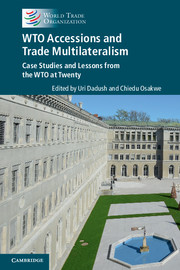Book contents
- Frontmatter
- Dedication
- Contents
- List of contributors
- Foreword
- Acknowledgements
- List of abbreviations
- Editors' note
- PART I WTO accessions, the trading system and the global economy
- 1 A reflection on accessions as the WTO turns twenty
- 2 Developments in the global economy and trading system effects: the transformation of world trade
- 3 The WTO and the global economy: contemporary challenges and possible responses
- 4 The structural reform implications of WTO accession
- 5 The macroeconomic implications of WTO accession
- 6 The future of Asia: unleashing the power of trade and governance
- 7 Eurasian Economic Union integration: timetable, priorities and challenges
- 8 WTO accessions: what does the academic literature say?
- PART II Overview: systemic outcomes from accessions
- PART III Members’ perspectives on accession negotiations
- PART IV Working party chairpersons’ perspectives on accession negotiations
- PART V Salient features inWTOAccession Protocols
- PART VI Conclusion
- Annex: Contributor biographies
- Index
- Plate section
7 - Eurasian Economic Union integration: timetable, priorities and challenges
from PART I - WTO accessions, the trading system and the global economy
Published online by Cambridge University Press: 05 November 2015
- Frontmatter
- Dedication
- Contents
- List of contributors
- Foreword
- Acknowledgements
- List of abbreviations
- Editors' note
- PART I WTO accessions, the trading system and the global economy
- 1 A reflection on accessions as the WTO turns twenty
- 2 Developments in the global economy and trading system effects: the transformation of world trade
- 3 The WTO and the global economy: contemporary challenges and possible responses
- 4 The structural reform implications of WTO accession
- 5 The macroeconomic implications of WTO accession
- 6 The future of Asia: unleashing the power of trade and governance
- 7 Eurasian Economic Union integration: timetable, priorities and challenges
- 8 WTO accessions: what does the academic literature say?
- PART II Overview: systemic outcomes from accessions
- PART III Members’ perspectives on accession negotiations
- PART IV Working party chairpersons’ perspectives on accession negotiations
- PART V Salient features inWTOAccession Protocols
- PART VI Conclusion
- Annex: Contributor biographies
- Index
- Plate section
Summary
ABSTRACT
This chapter focuses on the objectives of the Eurasian Economic Union (EAEU) of the Republic of Armenia, the Republic of Belarus, the Republic of Kazakhstan, Kyrgyz Republic and the Russian Federation within the multilateral trading system. The EAEU has become one of the largest trading blocs in the world, with a land area of more than 20 million square kilometres and a population of more than 176 million people.
This chapter analyses the history of Eurasian integration and presents its current status, as well as the prospects of the Eurasian Economic Union for 2015.
Eurasian integration: current standing
The process of integration in Eurasia began over two decades ago, almost immediately after the collapse of the Soviet Union. At that time, countries in the region were looking for new opportunities to renew their economic, industrial and trading ties, having faced a serious systemic crisis and growing social and political tensions.
Deep interdependence and advanced cooperative ties in the production and trade spheres, together with common cultural and language backgrounds, constituted a foundation for economic integration in Eurasia, which has developed progressively from the Commonwealth of Independent States (CIS) and the CIS Free Trade Area, to the Eurasian Economic Community (EurAsEC), to the Customs Union (CU) and the Single Economic Space (SES), to the EAEU (Armenia, Belarus, Kazakhstan, Kyrgyz Republic and Russia).
Today's EAEU provides an opportunity to acquire the experience of cooperating in open markets and enhancing administrative practices on the basis of WTO principles and norms.
In 2010, when the CU was established, its main elements – a single customs territory, common customs tariff and customs code – had been put in place. This led to immediate effects on internal CU trade. One of these was an increase in the mutual trade turnover of 33 per cent in 2011 as compared to 2010, and of 7.5 per cent in 2012 as compared to 2011.
The EAEU member states form a common market of goods, services, capital and labour, with total area of more than 20 million square kilometres (the largest in the world), a population of more than 176 million people, an aggregate nominal gross national product (GNP) of US$2,157.4 billion, and a foreign trade volume amounting to US$868.5 billion in 2014.
- Type
- Chapter
- Information
- WTO Accessions and Trade MultilateralismCase Studies and Lessons from the WTO at Twenty, pp. 187 - 197Publisher: Cambridge University PressPrint publication year: 2015



